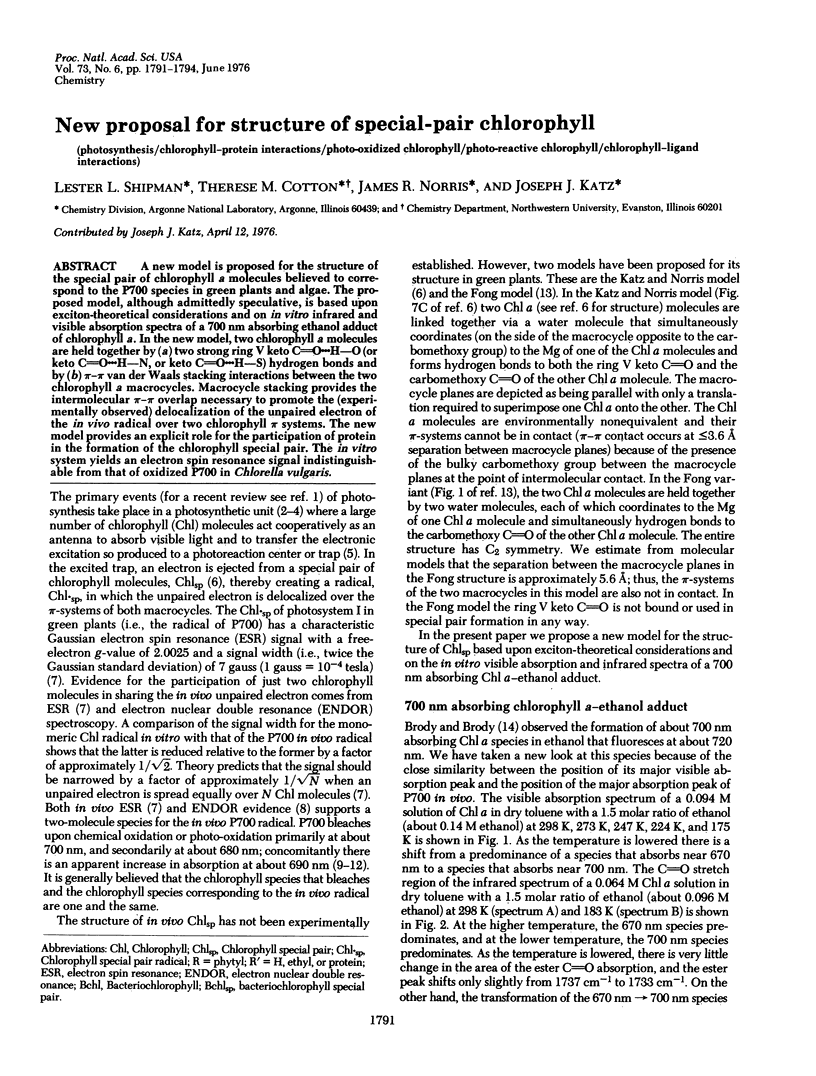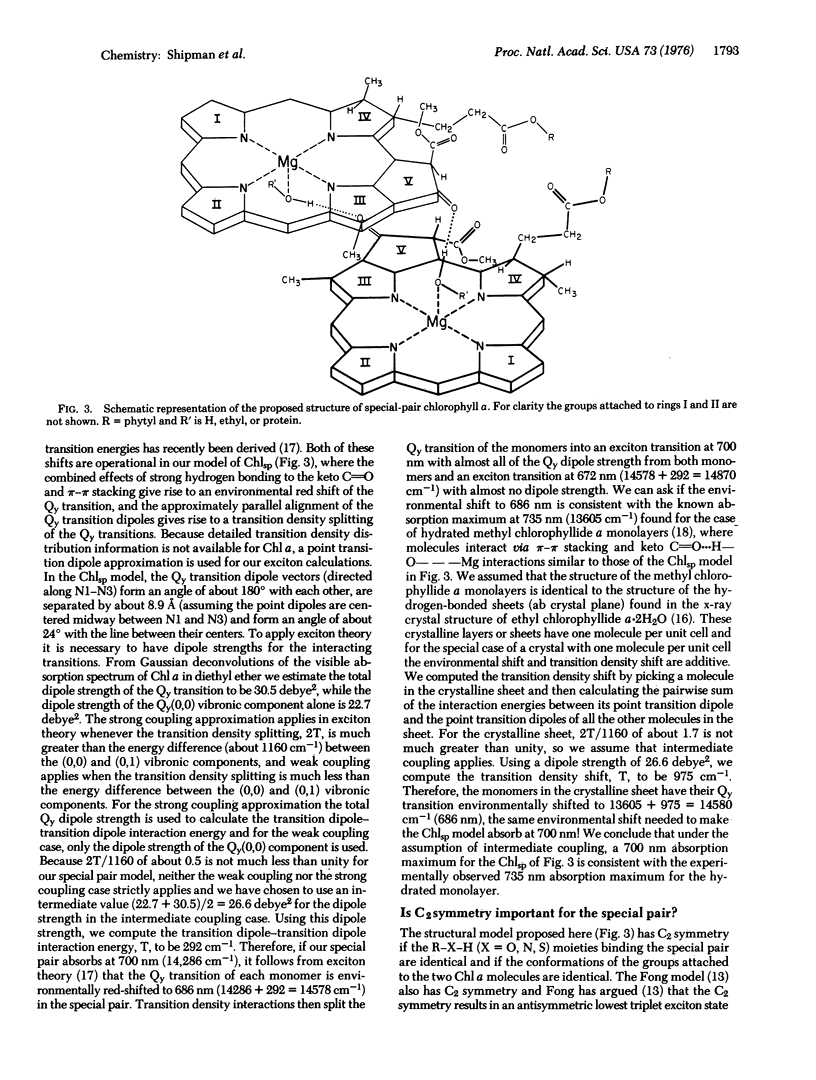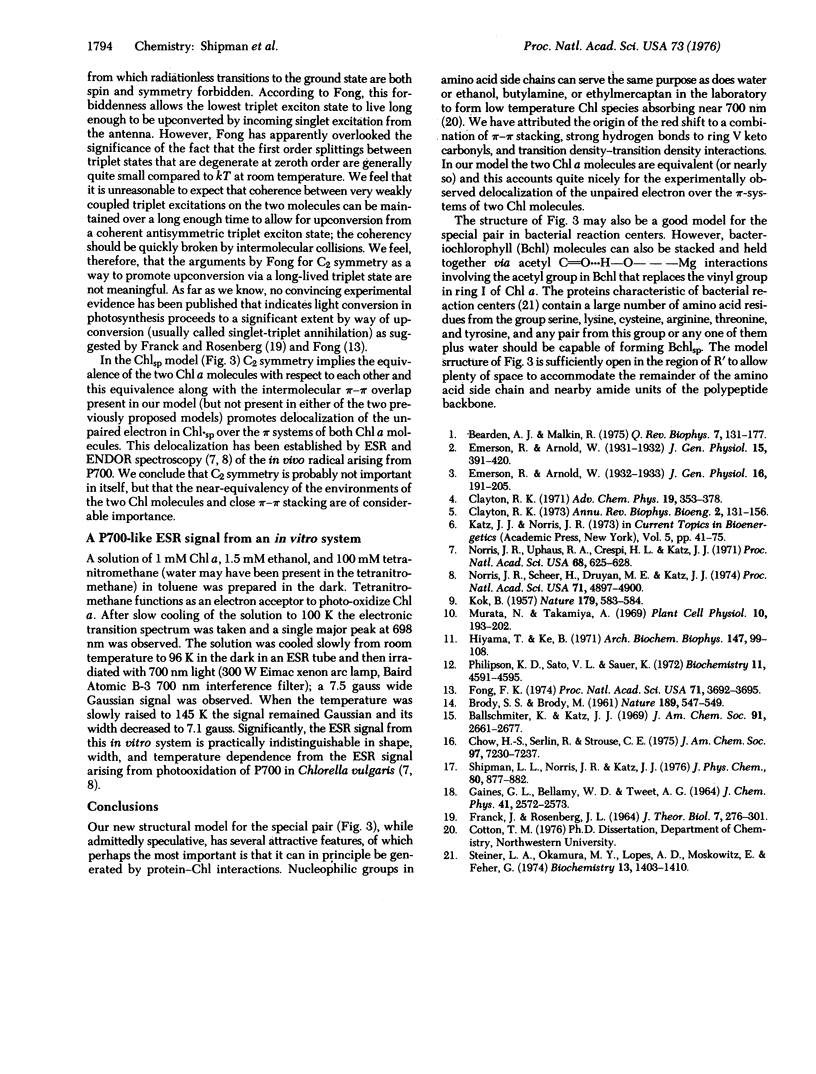Abstract
A new model is proposed for the structure of the special pair of chlorophyll a molecules believed to correspond to the P700 species in green plants and algae. The proposed model, although admittedly speculative, is based upon exciton-theoretical considerations and on in vitro infrared and visible absorption spectra of a 700 nm absorbing ethanol adduct of chlorophyll a. In the new model, two chlorophyll a molecules are held together by (a) two strong ring V keto C[unk]O[unk]H[unk]O (or keto C[unk]O[unk]H[unk]N, or keto C[unk]O[unk]H[unk]S) hydrogen bonds and by (b) π-π van der Waals stacking interactions between the two chlorophyll a macrocycles. Macrocycle stacking provides the intermolecular π-π overlap necessary to promote the (experimentally observed) delocalization of the unpaired electron of the in vivo radical over two chlorophyll π systems. The new model provides an explicit role for the participation of protein in the formation of the chlorophyll special pair. The in vitro system yields an electron spin resonance signal indistinguishable from that of oxidized P700 in Chlorella vulgaris.
Keywords: photosynthesis, chlorophyll-protein interactions, photo-oxidized chlorophyll, photo-reactive chlorophyll, chlorophyll-ligand interactions
Full text
PDF



Selected References
These references are in PubMed. This may not be the complete list of references from this article.
- Bearden A. J., Malkin R. Primary photochemical reactions in chloroplast photosynthesis. Q Rev Biophys. 1974 May;7(2):131–177. doi: 10.1017/s0033583500001396. [DOI] [PubMed] [Google Scholar]
- Clayton R. K. Primary processes in bacterial photosynthesis. Annu Rev Biophys Bioeng. 1973;2:131–156. doi: 10.1146/annurev.bb.02.060173.001023. [DOI] [PubMed] [Google Scholar]
- FRANCK J., ROSENBERG J. L. A THEORY OF LIGHT UTILIZATION IN PLANT PHOTOSYNTHESIS. J Theor Biol. 1964 Sep;7:276–301. doi: 10.1016/0022-5193(64)90073-6. [DOI] [PubMed] [Google Scholar]
- Fong F. K. Molecular basis for the photosynthetic primary process. Proc Natl Acad Sci U S A. 1974 Sep;71(9):3692–3695. doi: 10.1073/pnas.71.9.3692. [DOI] [PMC free article] [PubMed] [Google Scholar]
- Hiyama T., Ke B. A further study of P430: a possible primary electron acceptor of photosystem I. Arch Biochem Biophys. 1971 Nov;147(1):99–108. doi: 10.1016/0003-9861(71)90314-6. [DOI] [PubMed] [Google Scholar]
- Norris J. R., Scheer H., Druyan M. E., Katz J. J. An electron-nuclear double resonance (ENDOR) study of the special pair model for photo-reactive chlorophyll in photosynthesis. Proc Natl Acad Sci U S A. 1974 Dec;71(12):4897–4900. doi: 10.1073/pnas.71.12.4897. [DOI] [PMC free article] [PubMed] [Google Scholar]
- Norris J. R., Uphaus R. A., Crespi H. L., Katz J. J. Electron spin resonance of chlorophyll and the origin of signal I in photosynthesis. Proc Natl Acad Sci U S A. 1971 Mar;68(3):625–628. doi: 10.1073/pnas.68.3.625. [DOI] [PMC free article] [PubMed] [Google Scholar]
- Philipson K. D., Sato V. L., Sauer K. Exciton interaction in the photosystem I reaction center from spinach chloroplasts. Absorption and circular dichroism difference spectra. Biochemistry. 1972 Nov 21;11(24):4591–4595. doi: 10.1021/bi00774a027. [DOI] [PubMed] [Google Scholar]
- Steiner L. A., Okamura M. Y., Lopes A. D., Moskowitz E., Feher G. Characterization of reaction centers from photosynthetic bacteria. II. Amino acid composition of the reaction center protein and its subunits in Rhodopseudomonas spheroides R-26. Biochemistry. 1974 Mar 26;13(7):1403–1410. doi: 10.1021/bi00704a014. [DOI] [PubMed] [Google Scholar]


